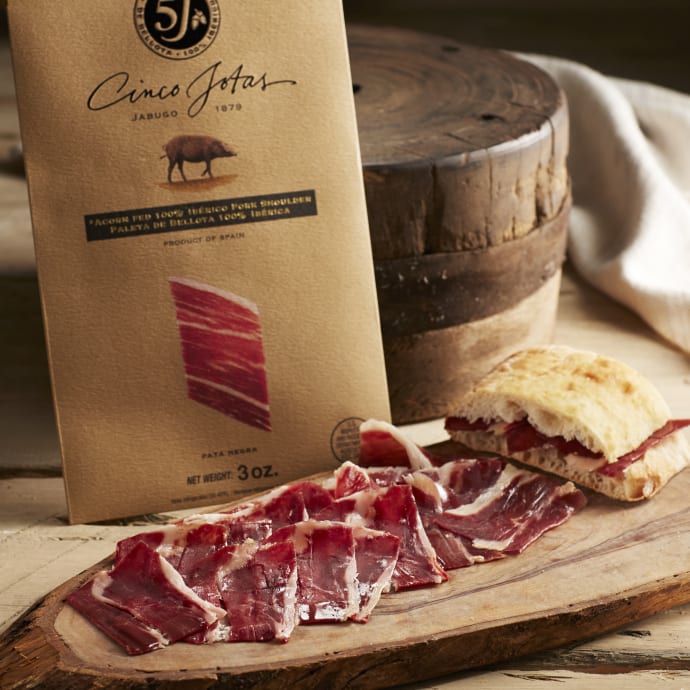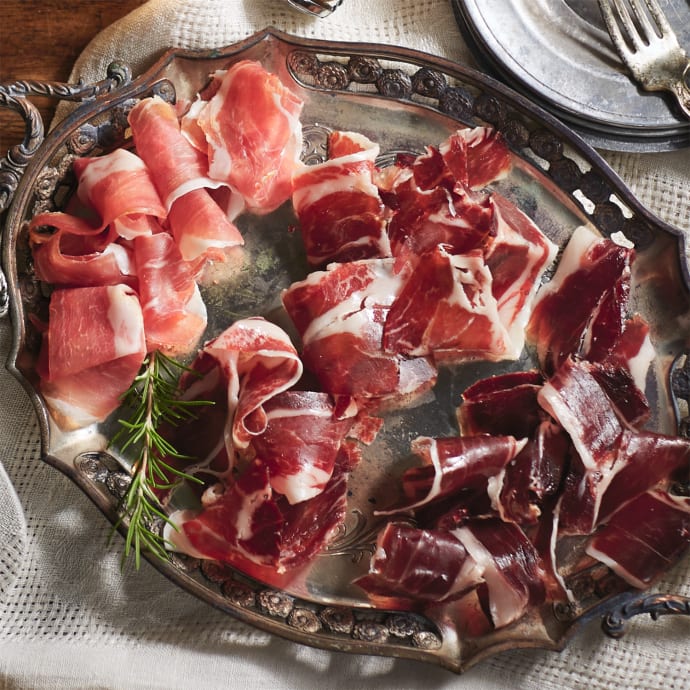This Spanish ham is some of the best that money can buy.
Jackie Bryant
To the untrained eye and palate, a ham is just a ham—usually, one entire pig leg or shoulder, sliced into short, rectangular, paper-thin sheets. But with so many types of ham on the market, it can be difficult to know which is the best and why. When it comes to Spanish ham, knowledge is power.
So if you're looking to buy some of the best jamón, or Spanish ham, that money can buy, make sure you know what you're looking for.
The different categories of jamón
Understanding the distinctions among the different kinds of Spanish ham is a good starting point, as each type is carefully designated by law.
Jamón Serrano is made from white pigs—usually Landrace or Duroc breeds, which have white hooves and are typically raised indoors and fed a mix of grains. The product is less fatty than Ibérico.
Jamón Ibérico is made from farm-raised, usually crossbred Ibérico pigs that are raised indoors and fed hay.
Jamón Ibérico Cebo de Campo is the next level above that and is made from crossbred free-range Ibérico pigs that are fed a mixture of acorns and hay.
Jamón Ibérico de Bellota, finally, is the premier level—the type that has inspired cult-like following—that is made from free-range, black-hued and footed Ibérico pigs that subsist solely on acorns.
Why acorns? The dehesas, or meadows, of western Spain serve a variety of economic and environmental purposes. The Holm and cork oak trees provide high-quality wood that is exported for the global wine industry (as well as for other purposes), and is the ideal canopy for the region’s flora and fauna. The acorns that come from the trees also happen to be the perfect food for free-range pigs: each pig can eat about 10 kilos of acorns a day and the result, after a long curing period of two to four years, creates a nutty, rich-tasting product that is high in monosaturated fat, high in oleic acid and low in saturated fat.
What to Look For
When possible, opt for hand-sliced over machine-sliced jamón, because master carvers slice in a way that properly distributes fat among the entire piece—something that cannot be replicated by a machine. Also, only buy ham that's been vacuum sealed.
But there's more to it, of course. One thing to notice is that there are three colors, which range from bright red in the more well-cured areas, to pink, says Teresa de la Cierva, Member of the Spanish Royal Academy of Gastronomy & Vice-president of the Gastronomy Academy of Madrid. “White marbled fat deposits a sheen when the meat is exposed to room temperature and small white “crystals” denote low salinity and gradual, slow curing. Hints of pink shown in the muscle fiber indicate prolonged curing, along with the purity of the breed.”
Then, there are the different cuts, many of which are not known outside of Spain. An Ibérico ham leg has four distinctive parts to it: the punta, babilla, maza and jarrete. Each has its own distinctive aroma, flavor and texture and, in southern and western Spain, can be paired with a different kind of Sherry, depending on whether it’s sweeter or drier, fatty or more fibrous.
“The meat in the top third of the ham, the maza, is soft, juicy and unctuous. It melts in your hands,” de la Cierva says. “The babilla, or contramaza, which is near the bottom of the ham and jarrete, which comes from a small area next to the ankle, feature a more fibrous and firm-bodied consistency which increases the chewing time and enjoyment.” The jarrete is the rarest cut of all—it takes a significantly skilled carver to be able to extract it from around the bone. The hard-to-reach punta, at the tip of the ham, is a bit sweeter and significantly more marbled.
Where to Buy It
The most premium brand from Spain, Cinco Jotas (5J), is also one of the main exporters of cured ham around the world and sells to the United States via its online shop. But specialty shops around the country, like Despaña in New York City, carry Jamón Iberico too, as do other online stores, like Virginia-based La Tienda, or even on Amazon.
Read full article...

 SHIPS FREE
SHIPS FREE SHIPS FREE
SHIPS FREE BEST SELLER
BEST SELLER BEST SELLER
BEST SELLER



